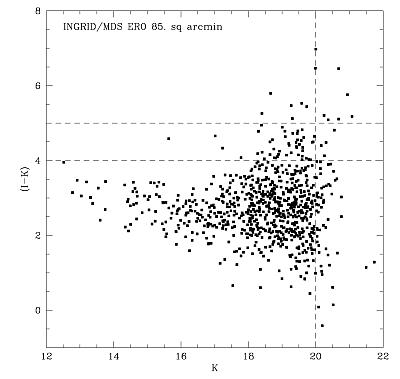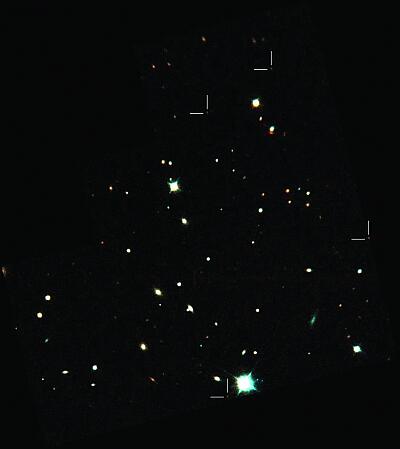We are taking advantage
of the wide-field near-infrared imaging capabilities of INGRID on the WHT
to construct a deep, wide area survey for Extremely Red Objects (EROs) in
archival Hubble Space Telescope Medium Deep Survey (MDS) fields.
The last five years have seen a growing appreciation of the diversity
of galaxy properties at z≥1–2. In part this has come about from an impressive
growth in our observational knowledge of galaxies at these redshifts —driven
by the availability of powerful new instruments on 4- and 8-m class telescopes.
However, an equal role has been played by the realisation of the necessity
of a multi-wavelength approach to studies of galaxy evolution at z≥1. Thus
a range of surveys spanning wavebands from the X-ray, near- and mid-infrared,
submillimeter and out to the radio, have complimented the traditional view
based on UV/optical observations. These new studies have all tended to
stress the role of dust obscuration in censuring our view of the galaxy
population at high redshifts, and especially in disguising the extent of
activity in the most active environments, both AGN and star-forming systems.
This is much more of a concern due to the very strong evolution seen in
obscured populations, which result in them dominating the bolometric emission
at high redshifts (e.g.
Haarsma
et al., 2000;
Smail
et al., 2002).
One of the most striking themes to arise from this new multi-wavelength
view of galaxy formation is the ubiquity of optically-faint, but bright
near-infrared counterparts to sources identified in many wavebands: in the
X-ray (
Cowie
et al., 2001;
Page
et al., 2001), the mid-infrared (
Pierre
et al., 2001;
Smith
et al., 2001), submillimeter (
Smail
et al., 1999;
Lutz
et al., 2001) and radio (
Richards,
1999;
Chapman
et al., 2002). This has resulted in a renaissance in interest in such
Extremely Red Objects —a class of galaxies which had previously been viewed
as a curiosity with little relevance to our understanding of galaxy formation
and evolution— comprising a mere 5–10% of the population down to K=20.
The ERO class is photometrically-defined —one frequently used definition
is I–K≥4 (or a more extreme selection of I–K≥5). This very red optical-near-infrared
colour is intended to effectively isolate two broad populations of galaxies
at z

1: those which are red by virtue of the presence of large amounts of dust
(resulting from active star formation), as well as passive systems whose
red colours arise from the dominance of old, evolved stars in their stellar
populations. The very different nature of these two sub-classes, dusty starbursts
and evolved ellipticals, has prompted efforts to disentangle their relative
proportions (
Pozzetti
& Mannucci, 2000) so that well-defined samples can be used to test
galaxy formation models (
Daddi
et al., 2000;
Smith
et al., 2002;
Firth
et al., 2002).
One particularly powerful approach is to use the morphology of the ERO
to distinguish regular, relaxed ellipticals from disturbed and dusty starbursts.
A common misconception is that the key to a successful ERO survey is
to obtain deep NIR imaging —in fact, the observationally most demanding aspect
is achieving the necessary depth in the optical to identify that a galaxy
is an ERO. For this reason, we have chosen to concentrate our survey on
fields for which deep, high-quality archival optical imaging already exists.
These fields come from the Medium Deep Survey (
Griffiths
et al., 1994) who have amassed over 500 deep HST/WFPC2 images of intermediate/
high-Galactic latitude blank fields. These represent high-resolution (0.1'')
and very deep (I~27) images of random areas of extragalactic sky. Using
a sample taken from the 100 deepest I-band MDS fields (covering an effective
area of 500 sq. arcmin) we are able to obtain morphological information
(sufficient to distinguish compact, regular evolved early-type galaxies
from the more distorted starbursts) for galaxies as faint as I=25. Six nights
of INGRID time in November 2000 and a further six in May 2001 have resulted
in over 50 MDS fields being imaged in Ks and more than 30 of these also
in J, to 5s limiting magnitudes of Ks=20 and J=22.5. It is thanks to the
generous field of view of INGRID that such a survey is possible in a reasonable
amount of telescope time. In contrast UFTI on UKIRT would take a factor
of 3–4 longer to tile each MDS field. These data will form the basis of
a sample of EROs with which we can undertake NIR spectroscopy on 8-m class
telescopes, selected from an area an order of magnitude larger than the Cimatti
et al. (2000) survey.
Preliminary results are shown in Figure 1. From 85 square arcmins, 55
EROs are found with I–K≥4 and 7 with I–K≥5. The samples from the full
survey of 260 sq. arcmin will be 170 and 20 respectively. A colour image
of one field made from INGRID data is illustrated in Figure 2. This survey
is supported by the Leverhulme Trust.

|

|
Figure 1. Preliminary I–K, K colour-magnitude
diagram from 85 sq. arcmins of data from our survey. These data cover 17
HST WFPC2 fields —with typical integration times of 6.0ks in the I (F814W)
passband and 3.0ks in the K-band with INGRID. The INGRID data for this survey
was taken in typically good conditions, 0.5–0.9'' FWHM, while the HST imaging
has nominally 0.1'' resolution, although poor signal to noise for the reddest
galaxies targeted here, I-K  4–5. We catalogue a total of 55 galaxies brighter than K=20 and redder
than I–K=4, of which 7 are redder than I–K=5. The equivalent sample for the
full survey will have around 170 and 20 respectively. [ JPEG | TIFF ]
4–5. We catalogue a total of 55 galaxies brighter than K=20 and redder
than I–K=4, of which 7 are redder than I–K=5. The equivalent sample for the
full survey will have around 170 and 20 respectively. [ JPEG | TIFF ]
|
Figure 2 (right). A “true colour” I/Ks image of
one of our fields. An extreme ERO, I–K>5, is visible to the south-east
of the brightest star. Other (I–K>4) EROs are indicated by arrows.The unusual
shape of the image arises from the coverage of the WFPC2 image. The field
is ~4' in diameter —meaning that the WFPC2 field is completely covered by
INGRID, irrespective of the roll angle of HST when the observations were taken.
The image reaches 5σ point source sensitivities of K~20 and I~26. [ JPEG | TIFF ]
|
References:
- Chapman, S. C., Lewis, G. F., Scott, D., Borys, C., Richards,
E., 2002, ApJ, 570, 557. [ Citation
in text | ADS
]
- Cimatti, A., Villani, D., Pozzetti, L., di Serego Alighieri, S.,
2000, MNRAS, 318, 453. [ Citation
in text | ADS
]
- Cowie, L. L., et al., 2001, ApJ, 551, L9. [
Citation in text | ADS
]
- Daddi, E., Cimatti, A., Renzini,A., 2000, A&A, 362,
L45. [ Citation in text | ADS
]
- Firth, A. E., et al., 2002, MNRAS, 332, 617. [
Citation in text | ADS
]
- Griffiths, R. E., et al., 1994, ApJ, 435, L19. [
Citation in text | ADS
]
- Haarsma, D. B., Partridge, R. B., Windhorst, R. A., Richards,
E. A., 2002, ApJ, 544, 641. [ Citation
in text | ApJ
]
- Lutz, D., et al., 2001, A&A, 378, 70. [
Citation in text | ADS
]
- Page, M. J., Mittaz, J. P. D., Carrera, F. J., 2001, MNRAS,
325, 575. [ Citation in text | ADS
]
- Pierre, M., et al., 2001, A&A, 372, L45. [
Citation in text | ADS
]
- Pozzetti, L., Mannucci, F., 2000, MNRAS, 317, L17. [
Citation in text | ADS
]
- Richards, E. A., 1999, ApJ, 513, L9. [ Citation in text | ADS
]
- Smail, I., et al., 1999, MNRAS, 308, 1061. [
Citation in text | ADS
]
- Smail, I., Ivison, R. J., Blain, A. W., Kneib, J.-P., 2002, MNRAS,
331, 495. [ Citation in text | ADS
]
- Smith, G. P., et al., 2001, ApJ, 562, 635. [
Citation in text | ADS
]
- Smith, G. P., Smail, I., Kneib, J.-P., Davis, C. J., Takamiya,
M., Ebling, H., Czoske, O., 2002, MNRAS, 333, L16. [
Citation in text | ADS
]
Email contact: David
Gilbank (
D.G.Gilbank@durham.ac.uk)



